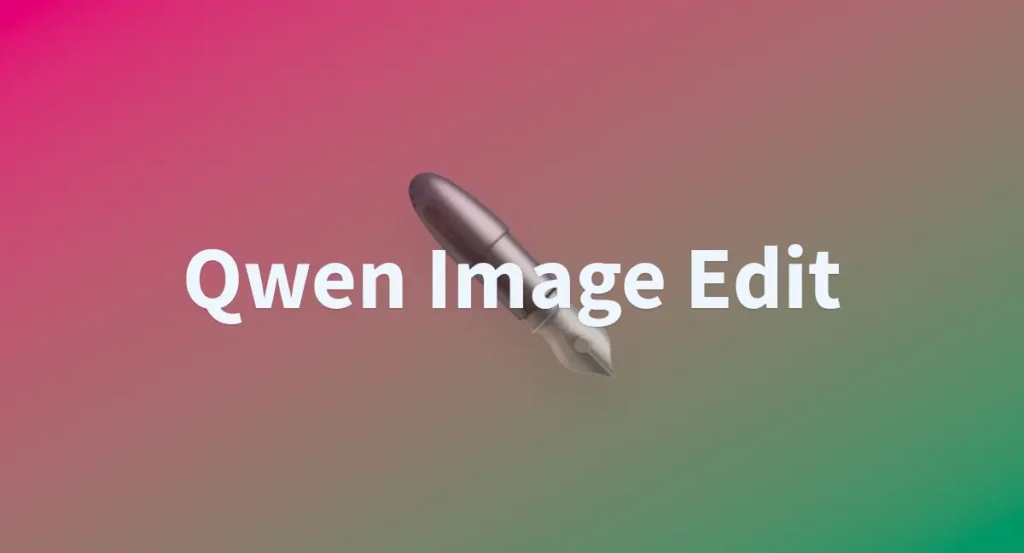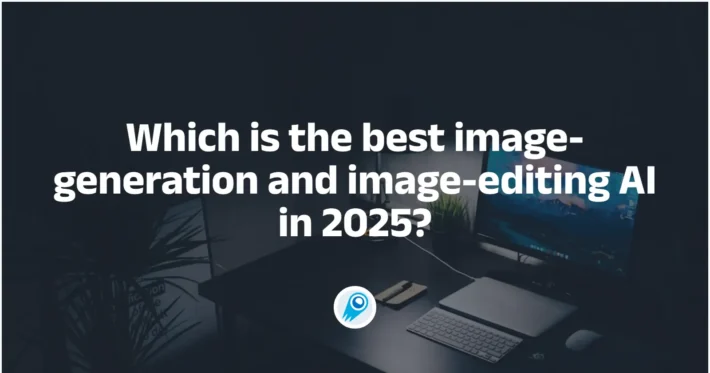Is Qwen-Image-Edit the 2025 Breakthrough Image-Editing AI

Alibaba’s Qwen team released Qwen-Image-Edit on August 19, 2025 — an image-editing variant built on the 20B Qwen-Image backbone that promises precise bilingual text editing, dual-mode semantic + appearance control, and SOTA benchmark performance.I’ll explain its deep dive into architecture, features, usage.
What is Qwen-Image-Edit and why does it matter?
Qwen-Image-Edit is an image-editing foundation model from Alibaba’s Qwen team, released August 19, 2025, built on the 20B-parameter Qwen-Image backbone. It extends Qwen-Image’s advanced text rendering to interactive image editing: bilingual (Chinese/English) text edits inside images, fine-grained appearance edits (remove/add/retouch), and higher-level semantic transformations (rotate objects, novel view synthesis, style transfer). The team highlights that the model feeds images to both a visual-language encoder and a VAE encoder to control semantics and appearance independently.
It’s explicitly designed for instruction-driven image edits: you provide an input image and a natural-language instruction (English and Chinese supported) and the model returns an edited image that can perform precise text edits, addition/removal of objects, style or color adjustments, and even higher-level semantic transformations while preserving visual consistency.
Why this matters: image editing is no longer just “paint or mask and composite” — models like Qwen-Image-Edit let you describe edits in natural language, preserve typography and layout, and make small-area corrections that used to require careful Photoshop work. That combination is especially valuable for creatives, e-commerce, marketing teams, and automation pipelines that need programmatic, repeatable visual edits.
How do you actually use Qwen-Image-Edit — what are the developer paths?
Where it’s available
You can experiment with Qwen-Image-Edit via:
- Qwen Chat (official web demo) for interactive editing.
- Hugging Face model page / Spaces — public model and demo spaces exist for quick trials.
- Alibaba Cloud Model Studio / DashScope API — production API (HTTP + SDKs) with documented endpoints, pricing and quotas for automated use.
Quick ways to try
- For a one-off or experimentation, use the Hugging Face Space or Qwen Chat.
- For integration (web app, batch pipeline, or backend service), call the DashScope endpoint (Alibaba Cloud Model Studio) using the provided HTTP API or DashScope SDKs (Python/Java). The Model Studio docs include curl and SDK examples for image URL or Base64 inputs, negative prompts, watermark options and the result retrieval flow.
How is Qwen-Image-Edit architected — what’s under the hood?
Dual-path input: semantics + appearance
According to the official writeup, Qwen-Image-Edit concurrently processes the input image through:
- Qwen2.5-VL (visual-language encoder) — drives semantic understanding and high-level edits (object rotation, view synthesis, content changes).
- VAE encoder / latent appearance path — preserves or manipulates low-level visual appearance (textures, exact pixel preservation for localized edits).
This split enables the model to do either broad semantic re-imagination or pixel-conservative edits on targeted regions.
Built on a 20B image foundation
The editing model extends the 20B Qwen-Image generation model (text rendering capabilities were central to Qwen-Image) so the editing variant inherits strong layout/text understanding and high fidelity image priors. The Qwen-Image repo and blog indicate Apache-2.0 licensing for the image codebase, which has accelerated community adoption.
Pipeline and practical flow
A typical pipeline (high level):
- Input image (public URL or Base64) plus a textual instruction/prompt and optional masks / bounding boxes for targeted edits.
- Model ingests image into both encoders; the visual-language encoder interprets the prompt in context and proposes semantic transformations; the VAE path encodes appearance constraints.
- Combining these modalities, the decoder produces the edited image — either globally changed (semantic edit) or locally modified (appearance edit) while leaving masked regions untouched. Outputs are stored as OSS links (when using Alibaba Cloud) with limited TTL.
During editing, Qwen-Image-Edit feeds the same input image into both channels so it can decide whether to alter structure vs. preserve appearance. This two-track architecture enables operations that range from pixel-accurate local removals (e.g., remove a hair strand without touching neighboring pixels) to radical semantic changes (e.g., change pose or generate novel viewpoints) while keeping subject identity consistent. The team also leaned heavily on advanced diffusion tooling and prompt enhancement utilities to stabilize chained edits.
What features does Qwen-Image-Edit offer?
Dual-track editing: semantic + appearance control
Qwen-Image-Edit is explicitly designed as a two-track editor: a semantic encoder that understands scene/layout/objects and a separate appearance pathway that preserves textures, fonts and fine-grained pixel detail. That design is what lets the model decide whether to change high-level composition (pose, object identity, style) or to do a pixel-accurate local fix (remove an object, keep neighboring pixels identical). This split is the central architectural idea behind many recent high-fidelity editors and is strongly emphasized in Qwen’s release notes.
Practical implication: you can ask for “remove the watermark from the lower-left without touching the logo” or “change the hand posture” and the model will apply different internal strategies for each task, reducing collateral artefacts on untouched regions.
Text-aware image editing and bilingual support
One of the model’s headline capabilities is precise text editing — it attempts to preserve font, stroke, spacing and layout while adding/removing/modifying text in both Chinese and English text elements. This is not just rendering new text but attempting to match the original typography. Qwen’s team highlights this capability repeatedly in their documentation and model card.
Practical implication: packaging, posters, UI screenshots and signage workflows can be automated—especially where exact font matching and bilingual edits matter.
Masking, region prompts, and progressive edits
Functionality includes explicit mask inputs (for inpainting/outpainting), region-aware prompts (apply change only within bounding box X), and support for multi-turn / chained edits (iteratively refining output). The API and diffusion pipeline support negative prompts and guidance-scale-like controls to tune how conservative vs. bold the edits are. These are standard in production-focused editing pipelines and are present in Qwen’s tooling.
Multi-task Training: Industry-leading Editing Consistency
Through an enhanced multi-task training paradigm, Qwen-Image-Edit supports a variety of tasks, including text-to-image (T2I), image-to-image (I2I), and text-guided image editing (TI2I).It is worth mentioning that Qwen-Image-Edit’s “chain editing” capability is particularly outstanding. For example, in the calligraphy correction scenario, the model can gradually correct incorrect characters through multiple rounds of iteration while maintaining the overall style consistency. This capability greatly improves creative efficiency and lowers the threshold for professional visual content creation.
How does Qwen-Image-Edit perform — is it really SOTA?
Benchmarks and claims
Qwen claim state-of-the-art performance across several editing benchmarks (the team emphasizes human preference tests and editing-specific suites), coverage report specific scores on an editing benchmark commonly referred to in the community as GEdit-Bench (English and Chinese variants). One report lists Qwen-Image-Edit scoring ~7.56 (EN) and 7.52 (CN) versus GPT Image-1 at ~7.53 (EN) and 7.30 (CN) — numbers that indicate Qwen’s edge particularly on Chinese text and mixed semantic/appearance tasks.
How does Qwen-Image-Edit compare with GPT Image-1 (OpenAI) and FLUX.1Kontext?
Below I compare along the practical axes teams care about: capability, text rendering, deployment, openness, and where each model’s strengths/weaknesses lie.
- Qwen-Image-Edit — dual-track architecture, strong bilingual text editing, open weights (Apache-2.0), 20B image backbone, explicitly tuned for mixed semantic & appearance edits; good option if you need on-prem control or Chinese/English typography fidelity.
- gpt-image-1 (OpenAI) — highly capable multimodal generator/editor available via OpenAI API; excels at general image generation, text rendering, and integrations (Adobe / Figma partnerships); closed weights, managed API, broad ecosystem integration and product polish. OpenAI’s docs describe it as a “natively multimodal” image model in the API.
- FLUX.1Kontext — positioned as a text-first image editing product with a family of models (Dev / Pro / Max); the vendor emphasizes a workflow that preserves character/consistency while allowing targeted edits; commercial product orientation with hosted UI and pro tiers. Public technical detail (e.g., parameter counts) is limited compared to Qwen.
Capability & quality:
- Text & typography: Qwen explicitly markets bilingual text fidelity. OpenAI’s gpt-image-1 also highlights accurate text rendering and is already integrated into design tools; the practical difference will come down to OCR-measured accuracy and font matching tests on your corpus. FLUX claims strong typography control but publishes fewer head-to-head numeric benchmarks.
- Semantic edits (pose / viewpoint): All three support high-level edits. Qwen’s dual-path approach is architected for this mix; OpenAI’s model is highly capable and benefits from massive product-grade prompt engineering; FLUX aims for user-friendly edit flows. The numeric GEdit-Bench snapshot shows Qwen slightly ahead in aggregate scores on the benchmarks reported so far.
Practical pick-list (developer guidance):
- Choose Qwen-Image-Edit if: bilingual text editing (Chinese+English), combined semantic+appearance workflows, and easy cloud demos/integrations matter. Good first choice for regionally targeted UIs and posters.
- Choose GPT-Image-1 if: you want proven instruction-following and integrations with mainstream design tools (Adobe, Figma) and you prioritize single-step creative transformations; be mindful of preservation trade-offs.
- Choose FLUX.1Kontext / fine-tuned FluxKontext if: you want a fine-tunable stack (you can retrain or adapt on private corpora) and you’re prepared to invest in dataset curation; recent research shows competitive scores after fine-tuning.
Getting Started via CometAPI
CometAPI is a unified API platform that aggregates over 500 AI models from leading providers—such as OpenAI’s GPT series, Google’s Gemini, Anthropic’s Claude, Midjourney, Suno, and more—into a single, developer-friendly interface. By offering consistent authentication, request formatting, and response handling, CometAPI dramatically simplifies the integration of AI capabilities into your applications. Whether you’re building chatbots, image generators, music composers, or data‐driven analytics pipelines, CometAPI lets you iterate faster, control costs, and remain vendor-agnostic—all while tapping into the latest breakthroughs across the AI ecosystem.
The latest integration Qwen-Image-Edit will soon appear on CometAPI, so stay tuned!While we finalize Qwen-Image-Edit Model upload, explore our other image edit models that such as Seedream 3.0,FLUX.1 Kontext ,GPT-image-1 on the your workflow or try them in the AI Playground. To begin, explore the model’s capabilities in the Playground and consult the API guide for detailed instructions. Before accessing, please make sure you have logged in to CometAPI and obtained the API key. CometAPI offer a price far lower than the official price to help you integrate.
Final verdict: where Qwen-Image-Edit fits in your stack
Qwen-Image-Edit is a significant step toward “text-first” image editing workflows and stands out on mixed tasks where typography and semantic understanding matter. It’s quickly accessible — cloud APIs for fast integration and open weights for advanced customization — but new releases like this require careful testing in your domain: chained edits, identity preservation, and edge fonts/scripts can need iteration and prompt engineering. The Qwen team is actively tuning the model and recommends using the latest diffusers commits and provided prompt-rewrite tools for best stability.
If your use case is large-scale production (high throughput, guaranteed latency, special security), treat the cloud API like any other managed ML service: benchmark in your region, plan for cost, and implement robust caching and result persistence (OSS TTL considerations).

